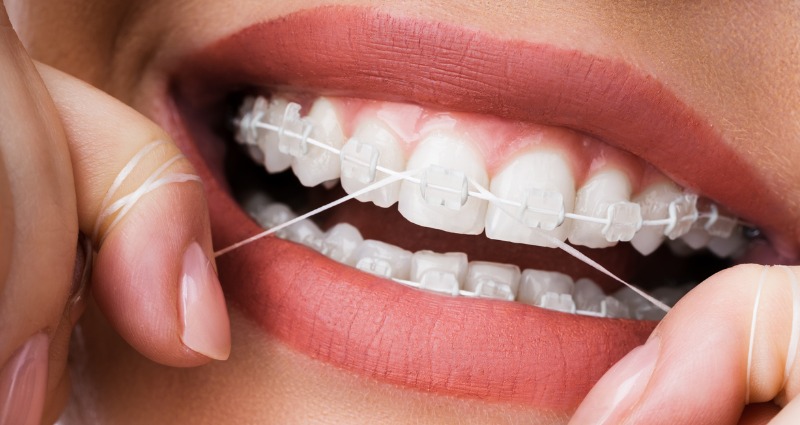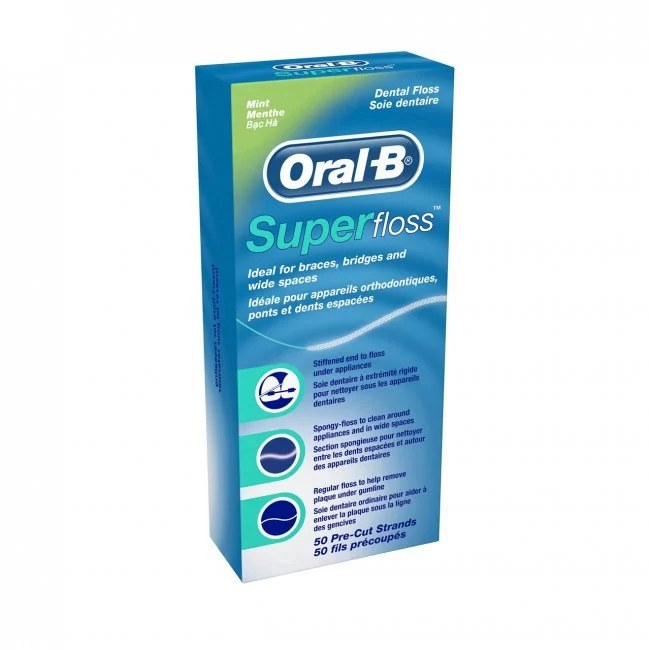
Flossing with braces may seem an impossible task at first. But with practise it soon becomes second nature and an extension of brushing your teeth.
Why is Flossing So Important?
You might wonder how a small piece of floss can make much difference to your oral health. But you’ll be surprised at how effective flossing is. No matter how well you brush your teeth, no toothbrush can get into all the nooks and crannies like floss can.
By brushing and flossing, you’re removing food and bacteria that can lead to staining and cavities. It also helps prevent gingivitis and other oral health problems that can be a problem later in life. Brush at least twice and floss once daily.
How to Floss With Braces
It’s true, flossing with braces is tricky at first. But with a little patience, you’ll get the hang of it and you’ll be a pro in no time. Flossing also takes time, but if you ask us, it’s totally worth it!
Follow Our Steps
Step 1
Brush your teeth to remove bacteria, food particles and plaque. Make sure your brush reaches all surfaces of your teeth (outer surface, inner surface and flat surfaces of your top and bottom arch).
Step 2
Take a piece of floss around 20 cm long and wrap the ends around your index finger so you have a tight grip. ( we use superfloss as it has a thick spongy part that really does a great job cleaning).
Step 3
Line up the floss with the gap between your teeth and thread between the wire and your teeth.
Step 4
Move the floss between the teeth, along the vertical sides of each tooth and into the movable gum tissue to remove any food particles and plaque build-up.
Step 5
Curl the used floss around your finger after flossing each tooth so you don’t put germs back into your mouth.
Step 6
Move on to the next tooth and repeat the process.
Products Available for Flossing Teeth
There are a few alternative products available on the market now for cleaning your interdental space, not just wax floss. Experiment to see which one you prefer.
Dental Floss
Most people are familiar with dental floss, it has been around for 200 years. It started out as waxen silk thread, but we now use waxed or unwaxed nylon. The waxed version is a little thicker than unwaxed floss, but unwaxed is a little more likely to get caught on braces. We recommend that you try Superfloss, an Oral-B product because of the the broader spongy length that makes it cover more surface area.
To make using floss around your braces easier, you could try a floss threader. The threader helps get past the wire and between each tooth. Parents may need to help young children with flossing until they can manage it themselves.

Interdental Brushes
Interdental brushes have small bristles that make it easy to get in between teeth to remove food and plaque. Place the brush between teeth and brush gently back and forth a few times to dislodge any particles of food. Interdental brushes are designed for use with water only not toothpaste as it can be too abrasive.
They’re available in different widths to suit the size of the gaps between your teeth and last between three days and three weeks before you need to replace the brush.
There is some research to show that interdental brushes are less aggressive than floss on the gums because the brushes don’t cut into the gums like floss can. The bristles on the brush may also be more effective than dental floss at removing bacteria in the interdental space.
Water Flosser
A water flosser sprays water between the teeth to remove food. Water flossers are also good for removing food around the brackets and wires, but aren’t necessary because your toothbrush and floss can do the same job.
A water flosser is good for people who don’t like to use floss because they find it fiddly or tedious. Water flossers are easier to manoeuvre and use than floss, particularly for people who have arthritic hands.
So, the choice is yours. Choose whichever flossing tool you’ll use every day.
FAQs on Flossing with Braces
Is It More Important for People with Braces to Floss?
Yes, wearing braces means there are far more areas where food particles can get trapped and this attracts bacteria. The bacteria produce acids and form plaque. Effective brushing and flossing is the best way of removing as much bacteria as possible from teeth.
Considering Orthodontic Treatment as an Adult?
Get the smile you’ve always wanted with our innovative adult orthodontic treatment! Improve your smile and book an appointment!
Why Does Flossing Hurt?
Flossing may hurt your gums if you haven’t flossed consistently. If that’s the case, keep up with flossing and your gums will settle down.
Should I Keep the Floss Away from My Gums?
It’s important to use floss in your gum line, but you want to do it carefully. If you pull the floss down hard into the gum, you risk bruising. Floss gently by curving the floss around the base of the tooth (in a C shape) so the floss can get into the tooth pocket without causing any damage.
Can You Floss Before Brushing?
If you have food stuck between your teeth or braces, you can use floss to help dislodge it. Most people prefer to floss after brushing their teeth but it’s your choice. The most important part is that you floss, whatever the order.
Do I Need to Floss Every Day?
It only takes 24-36 hours for plaque to harden on teeth. By flossing every 24 hours, you don’t give plaque the chance to harden. Once plaque has hardened, it harbours more bacteria in the mouth and can lead to cavities.
Need Help with Your Flossing?
If you have questions about brushing or flossing your teeth, contact the clinic today and speak to one of our friendly dental therapists who will answer all your questions. At any of your appointments, we can give you another demonstration on how to brush or floss. Persist with flossing as it takes a little time and patience with braces to become proficient.